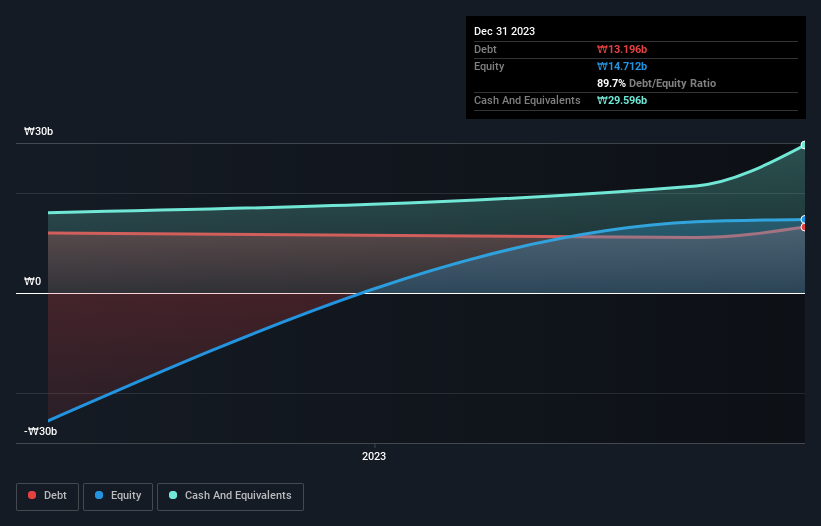The external fund manager backed by Berkshire Hathaway's Charlie Munger, Li Lu, makes no bones about it when he says 'The biggest investment risk is not the volatility of prices, but whether you will suffer a permanent loss of capital.' When we think about how risky a company is, we always like to look at its use of debt, since debt overload can lead to ruin. Importantly, Crowdworks, Inc. (KOSDAQ:355390) does carry debt. But should shareholders be worried about its use of debt?
Why Does Debt Bring Risk?
Debt assists a business until the business has trouble paying it off, either with new capital or with free cash flow. In the worst case scenario, a company can go bankrupt if it cannot pay its creditors. However, a more frequent (but still costly) occurrence is where a company must issue shares at bargain-basement prices, permanently diluting shareholders, just to shore up its balance sheet. Of course, debt can be an important tool in businesses, particularly capital heavy businesses. When we think about a company's use of debt, we first look at cash and debt together.
View our latest analysis for Crowdworks
How Much Debt Does Crowdworks Carry?
The image below, which you can click on for greater detail, shows that at December 2023 Crowdworks had debt of ₩13.2b, up from ₩11.1b in one year. However, it does have ₩29.6b in cash offsetting this, leading to net cash of ₩16.4b.

How Strong Is Crowdworks' Balance Sheet?
According to the last reported balance sheet, Crowdworks had liabilities of ₩26.3b due within 12 months, and liabilities of ₩1.84b due beyond 12 months. Offsetting these obligations, it had cash of ₩29.6b as well as receivables valued at ₩1.20b due within 12 months. So it can boast ₩2.64b more liquid assets than total liabilities.
This short term liquidity is a sign that Crowdworks could probably pay off its debt with ease, as its balance sheet is far from stretched. Simply put, the fact that Crowdworks has more cash than debt is arguably a good indication that it can manage its debt safely. The balance sheet is clearly the area to focus on when you are analysing debt. But you can't view debt in total isolation; since Crowdworks will need earnings to service that debt. So when considering debt, it's definitely worth looking at the earnings trend. Click here for an interactive snapshot.
In the last year Crowdworks wasn't profitable at an EBIT level, but managed to grow its revenue by 51%, to ₩24b. Shareholders probably have their fingers crossed that it can grow its way to profits.
So How Risky Is Crowdworks?
By their very nature companies that are losing money are more risky than those with a long history of profitability. And the fact is that over the last twelve months Crowdworks lost money at the earnings before interest and tax (EBIT) line. And over the same period it saw negative free cash outflow of ₩4.6b and booked a ₩9.6b accounting loss. But the saving grace is the ₩16.4b on the balance sheet. That means it could keep spending at its current rate for more than two years. Crowdworks's revenue growth shone bright over the last year, so it may well be in a position to turn a profit in due course. Pre-profit companies are often risky, but they can also offer great rewards. When analysing debt levels, the balance sheet is the obvious place to start. But ultimately, every company can contain risks that exist outside of the balance sheet. For instance, we've identified 2 warning signs for Crowdworks (1 is significant) you should be aware of.
If you're interested in investing in businesses that can grow profits without the burden of debt, then check out this free list of growing businesses that have net cash on the balance sheet.
New: AI Stock Screener & Alerts
Our new AI Stock Screener scans the market every day to uncover opportunities.
• Dividend Powerhouses (3%+ Yield)
• Undervalued Small Caps with Insider Buying
• High growth Tech and AI Companies
Or build your own from over 50 metrics.
Have feedback on this article? Concerned about the content? Get in touch with us directly. Alternatively, email editorial-team (at) simplywallst.com.
This article by Simply Wall St is general in nature. We provide commentary based on historical data and analyst forecasts only using an unbiased methodology and our articles are not intended to be financial advice. It does not constitute a recommendation to buy or sell any stock, and does not take account of your objectives, or your financial situation. We aim to bring you long-term focused analysis driven by fundamental data. Note that our analysis may not factor in the latest price-sensitive company announcements or qualitative material. Simply Wall St has no position in any stocks mentioned.
About KOSDAQ:A355390
CrowdWorks
Crowdworks, Inc. develops online crowd sourcing platform for artificial intelligent, which engages in collecting, strengthening, and structuring leaning data for machine learning.
Flawless balance sheet with very low risk.
Market Insights
Weekly Picks

Solutions by stc: 34% Upside in Saudi's Digital Transformation Leader


The AI Infrastructure Giant Grows Into Its Valuation
Recently Updated Narratives


Not a Bubble, But the "Industrial Revolution 4.0" Engine


The "David vs. Goliath" AI Trade – Why Second Place is Worth Billions


The "Sleeping Giant" Wakes Up – Efficiency & Monetization
Popular Narratives


MicroVision will explode future revenue by 380.37% with a vision towards success


NVDA: Expanding AI Demand Will Drive Major Data Center Investments Through 2026



